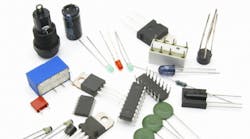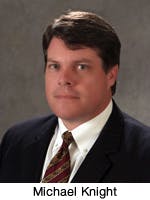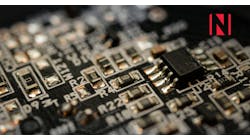TTI’s Michael Knight calls for a mixed business outlook as we head toward the end of 2013, pointing to a strong third quarter for TTI and an anticipated healthy start to 2014. But economic challenges still persist, and he points to the relatively flat conditions the industry has seen over the last two years as what may be the new normal for the electronic components business. The tightening of government spending, a weak job market and the threat of inflation all point to a bumpy road ahead as distributors and manufacturers seek growth in 2014. Challenges aside, Knight says he’s confident TTI’s business model will weather the storm.
Knight also talked about how the Internet continues to change the business landscape, the ongoing need for technological investment in the distribution channel and the importance of industry-supported education efforts such as the FIRST (For Inspiration and Recognition of Science and Technology) Robotics program. What follows are excerpts from our conversation:
Global Purchasing: With just a couple of months left in 2013, what is your outlook for the electronics industry in the year ahead?
Michael Knight: Q3 held together pretty well for us in all regions and for most other distributors and suppliers that I have spoken to. This leaves me feeling optimistic about some growth in the fourth quarter. Though it is early days yet in October, our results have been very strong, and the engineering activity that our Mouser subsidiary is seeing is quite perky, further fueling my optimism. For me, this suggests that we should see a strong start to the New Year.
But as for the full year itself, my optimism starts to fade as we move into the second half. There are still some strong headwinds we are battling and things like a full year of sequestration, a full year of pull back on government stimulus spending around the world, the realization that at some point we are going to see some inflation here in the states, and a weak job market that continues to dampen consumer confidence, all have me worried that we could see a bit of a stall some time next year. Bottom line, here in the states I think we are going to see our industry grow in line with GDP growth this year and next, but probably not much better than that.
Global Purchasing: What are some of the key changes you see occurring in the electronics distribution business today?
Knight: We are a couple of years into a strong buyers market where OCMs have free capacity and pretty stable product lead times. In our business, this has resulted in some pretty aggressive price erosion that masks the fact that our unit shipments have in fact been growing pretty well. But the net result is that our industry overall is getting ready to finish its third year of basically running flat. So the biggest change I see is that our industry is not outperforming the overall economies in which we operate. Historically, we tend to grow two times faster than GDP, and drop only about two-thirds of GDP decline. This has me wondering if distribution, and the overall components industry, has in fact slipped over the crest of the infamous maturity bell curve.
Global Purchasing: You’ve mentioned in the past your concern about the lack of Internet resale guidelines in the electronics industry. What’s your position on this?
Knight: The Internet is a terrific tool for the purchasing community to quickly search for parts and test pricing. But given that the Internet is unregulated, the search leads to lots of unauthorized sources so the searcher has to be concerned about the validity of the information they are seeing, and the authenticity of the product behind that information. Maybe the best acid test is the old adage that if a deal looks too good to be true, it probably is.
Regarding pricing and availability information, there are a few gotcha’s that searchers should be aware of. The first is that, more and more often, the part quantities that they are finding are misleading. On most aggregated inventory search sites it is common to find instances of multiple sources for a given part number showing the same inventory. The most common way that this happens is when a supplier, a master distributor or a parent company provides an inventory feed to other companies, which in turn post that on the Internet as if these were unique parts existing exclusively in their inventory. So an important qualifying question of any source is, “Do you own these parts today? Are they in your warehouse?”
Another thing to watch out for is one-time pricing that a source might post to get rid of excess inventory or parts that are out of date code. If the searcher is only working on a spot buy, then these bargains are fantastic. But if the searcher is costing out a bill of material for an on-going project, this can cause a problem. Another common practice for even authorized distributors is to post teaser prices on parts that they have no sales history on and are not stocking. This is a good way to build some history and traction. If a part catches on, they then will stock it and raise the posted price. An industry-specific adage is that when you don’t actually have any parts to sell, all you have left to sell is price. If the searcher can wait factory lead-time then of course, take the price. If not, they should watch out for this “gotcha”.
Global Purchasing: You’re a big fan of the FIRST (For Inspiration and Recognition of Science and Technology) program, which encourages elementary, middle and high school students to get involved in science and math. Why do you think this program is so important to the electronics industry?
Knight: The U.S. is still an innovation leader, especially when it comes to technology. But with the emphasis that other countries are putting on STEM (science, technology, engineering and mathematics) education, often utilizing U.S. universities, that lead we have is narrowing. There is plenty written on this. There is also a lot written on declines in STEM-related scores of students, the declining rates of students pursuing STEM-related studies later in their education, and looming shortages of engineers for businesses.
The electronic component industry of tomorrow (which begins the day after today) is entirely dependent on these trends being reversed, and robotics programs like that of FIRST are fantastic examples of “we the people” stepping up to doing something proactive about this rather than leaving it to the government to solve. In addition to the STEM skills that FIRST teaches, there are lots of other great business skills that the student participants develop—for example, team work, organization, funding, marketing, competitor assessment, joint venturing—that set them up to be successful in the business world later in life.
Supporting FIRST, and similar STEM programs, is a win for the industry, a win for the country, and also feels really good at a personal level. The attitude and abilities of the kids I have interacted with in these programs is inspiring.
Global Purchasing: What sets TTI apart from the competition today? What things are you doing differently to stay ahead of the competition?
Knight: Our chief differentiators today are those that have been the core of how we have competed since our founding 42 years ago—the consistency and quality of our people and our inventory, and our decision to specialize on passives, connectors and electro-mechanical components. I just attended the ERA Conference for Manufacturers’ Reps in Chicago where I heard over and over again that the TTI business model is still relevant and, while not entirely unique to us, one that we put to practice better than any other. The many awards we continue to receive from customers (most recently, GE Aerospace) and suppliers further validate this.
So in answer to the question, “what are we doing differently to stay ahead of the competition?” as odd as it sounds, we are deliberately making every effort to stay strong and true to our business model. This includes carefully thought out, occasional acquisitions, like Sager Electronics last year, that help strengthen us in our areas of specialization and/or geographies where we are less well established and have lower share.
As the ways in which the buyers and engineers in the customer community get and manage information and parts evolve, we are investing in new tools and services, many of them Internet-based, in order to keep pace with the customer, and keep ahead of our competitors. Right now we are doing a lot of primary research in this area, and we are devoting significant marketing and IT resources to modernizing and optimizing how we communicate and transact with our customers. But our time-tested business model serves as the foundation for everything we do.
Today, and for as far into the future as I can imagine, distribution remains a people and parts business, and TTI has the best of both. We may not always deliver the best piece-price, but we do deliver the best total cost of ownership and best customer experience.
Michael Knight is senior vice president, Americas, for TTI Inc., which ranked 4th in Global Purchasing’s 2013 Top 50 Distributors report, with $1.6 billion in sales.









